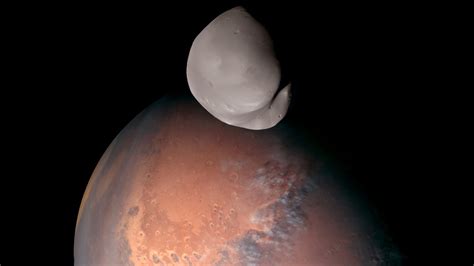Mars Deimos

The fascination with Mars and its moons has intrigued scientists and space enthusiasts alike for decades. Among the two natural satellites of Mars, Deimos stands out as a unique celestial body with its own set of characteristics and mysteries. In this comprehensive article, we delve into the world of Deimos, exploring its formation, physical attributes, exploration history, and the intriguing prospects it presents for future scientific endeavors.
The Enigmatic Moon: Unveiling the Secrets of Deimos

Deimos, named after the Greek god of terror, is the smaller and outermost moon of Mars. Its existence was first predicted by Jonathan Swift in his satirical novel Gulliver’s Travels, published in 1726. However, it wasn’t until 1877 that American astronomer Asaph Hall successfully discovered Deimos and its sister moon, Phobos. This section explores the captivating history and formation theories surrounding Deimos.
Formation and Origin Theories
The origin of Deimos remains a subject of ongoing debate among planetary scientists. Two primary theories dominate the discussion: the capture theory and the co-formation theory. The capture theory proposes that Deimos and Phobos were originally asteroids, captured by Mars’ gravitational pull as they wandered through the inner Solar System. This theory is supported by the moons’ irregular shapes and relatively low density, which resemble that of asteroids rather than typical moons.
On the other hand, the co-formation theory suggests that Deimos formed alongside Mars, approximately 4.5 billion years ago, from the same disk of gas and dust that gave birth to the planet. This theory is backed by the relatively low eccentricity of Deimos' orbit, which aligns with the co-formation hypothesis. Further exploration and analysis of Deimos' composition and internal structure could provide crucial insights to validate one of these theories.
Physical Characteristics
Deimos measures approximately 12.4 kilometers (7.7 miles) in diameter, making it significantly smaller than its sibling moon, Phobos. Its shape is irregular, resembling a lumpy potato, with its longest axis oriented towards Mars. The moon’s surface is heavily cratered, with the most prominent feature being the 2.3-kilometer (1.4-mile) wide Swift crater, named after the aforementioned author.
The regolith (loose surface material) of Deimos is thought to be composed primarily of rocks and dust, with a higher concentration of iron-rich minerals compared to Phobos. This composition suggests that Deimos may have experienced more intense space weathering than Phobos, possibly due to its greater distance from Mars and its resulting exposure to more cosmic radiation.
| Parameter | Value |
|---|---|
| Mean Radius | 6.2 km |
| Surface Area | Approx. 500 square km |
| Volume | Approx. 240 cubic km |
| Mean Density | 1.7 g/cm3 |
| Escape Velocity | 5.6 m/s |

Deimos' surface is relatively dark, reflecting only about 3% of the sunlight that reaches it. This low albedo indicates a high concentration of iron-rich minerals on the moon's surface. Additionally, Deimos lacks an atmosphere, resulting in extreme temperature variations, ranging from approximately -42°C (-44°F) during the day to -128°C (-198°F) at night.
Exploration History
The exploration of Deimos has been limited compared to its more famous counterpart, Phobos. However, several missions have provided valuable insights into this enigmatic moon.
The Mariner 9 mission, launched in 1971, was the first spacecraft to orbit Mars and capture images of Deimos. This mission revealed the moon's irregular shape and heavily cratered surface. Subsequently, the Viking orbiters, which arrived at Mars in the late 1970s, provided more detailed images and data about Deimos' surface features and composition.
In recent years, the Mars Global Surveyor and the Mars Reconnaissance Orbiter have contributed to our understanding of Deimos. These missions have captured high-resolution images and spectral data, allowing scientists to study the moon's surface composition and search for potential resources.
Prospects for Future Exploration
Deimos presents an intriguing opportunity for future scientific exploration and potential human habitation. Its relatively stable orbit and low gravitational pull make it an ideal candidate for establishing a permanent base or even a fuel depot for future Mars missions. Additionally, the moon’s surface could potentially harbor resources such as water ice or minerals that could be utilized for life support systems and fuel production.
Several proposed missions aim to explore Deimos further. The Phobos and Deimos Sample Return Mission, planned by the European Space Agency (ESA) and Roscosmos, aims to collect samples from both moons and return them to Earth for analysis. This mission could provide invaluable insights into the formation and evolution of these moons and, by extension, Mars itself.
Furthermore, the Mars Sample Return Campaign, a collaborative effort between NASA and ESA, includes a potential Deimos flyby during its journey back to Earth. This flyby would enable detailed imaging and spectroscopic analysis of the moon's surface, contributing to our understanding of its composition and potential resources.
Unraveling the Mysteries: Deimos’ Impact on Mars and Beyond

Deimos’ impact on Mars and our understanding of the Solar System extends beyond its physical attributes. The study of this moon provides crucial insights into the formation and evolution of planetary systems, offering a unique perspective on the early history of our cosmic neighborhood.
Understanding Planetary Systems
The presence of Deimos and Phobos offers a rare opportunity to study the dynamics of a binary moon system. By analyzing the moons’ orbits and interactions with Mars, scientists can gain insights into the processes that shape planetary systems. This knowledge is invaluable for understanding the formation and evolution of moons and planets throughout the Solar System and beyond.
Impacts on Mars’ Geology
Deimos’ orbit and gravitational influence have had a subtle but significant impact on Mars’ geology. The tidal forces exerted by Deimos, along with Phobos, have contributed to the formation and evolution of Mars’ distinctive features, such as its massive volcanoes and extensive canyon systems. Understanding these influences provides a deeper understanding of Mars’ geological history and its unique characteristics.
Implications for Future Space Exploration
Exploring and potentially harnessing the resources of Deimos could have far-reaching implications for future space exploration. The moon’s low gravity and stable orbit make it an ideal staging ground for missions to Mars and beyond. By establishing a base on Deimos, future astronauts could acclimate to the low-gravity environment and conduct scientific research, potentially paving the way for more ambitious missions to Mars and the outer Solar System.
Moreover, the resources available on Deimos, such as water ice and minerals, could be utilized to produce fuel, oxygen, and other vital supplies, reducing the need for costly and time-consuming resupply missions from Earth. This self-sufficiency could significantly enhance the sustainability and feasibility of long-duration space missions.
Conclusion: A Celestial Treasure Trove
Deimos, the smaller moon of Mars, is a captivating celestial body that holds numerous secrets and untapped potential. From its enigmatic formation to its unique physical characteristics and orbital dynamics, Deimos offers a wealth of scientific discoveries and practical applications for future space exploration.
As we continue to explore and study this moon, we gain a deeper understanding of our cosmic neighborhood and the processes that shape it. The insights gained from Deimos will not only enhance our knowledge of Mars and its moons but also contribute to our understanding of the origins and evolution of planetary systems throughout the universe.
With ongoing missions and future plans for Deimos exploration, the moon's mysteries will gradually unravel, revealing its true nature and unlocking its potential as a key player in humanity's journey beyond Earth.
How does Deimos compare to Earth’s Moon in terms of size and composition?
+Deimos is significantly smaller than Earth’s Moon, with a diameter of approximately 12.4 kilometers compared to the Moon’s 3,476 kilometers. In terms of composition, Deimos is thought to be more similar to an asteroid, with a higher concentration of iron-rich minerals and a lower density. Earth’s Moon, on the other hand, is composed primarily of silicate rocks and has a higher mean density.
What is the significance of Deimos’ low albedo?
+Deimos’ low albedo, reflecting only about 3% of sunlight, indicates a high concentration of iron-rich minerals on its surface. This dark appearance suggests that Deimos has experienced significant space weathering, potentially due to its greater distance from Mars and exposure to cosmic radiation. The low albedo also contributes to the moon’s extreme temperature variations.
How does Deimos’ orbit differ from that of Phobos, and what implications does this have for future exploration?
+Deimos orbits Mars at a greater distance and has a more circular and stable orbit compared to Phobos. This stability makes Deimos a more favorable candidate for establishing a permanent base or fuel depot for future Mars missions. Its orbit also suggests that Deimos may have formed alongside Mars, providing valuable insights into the planet’s early history.


